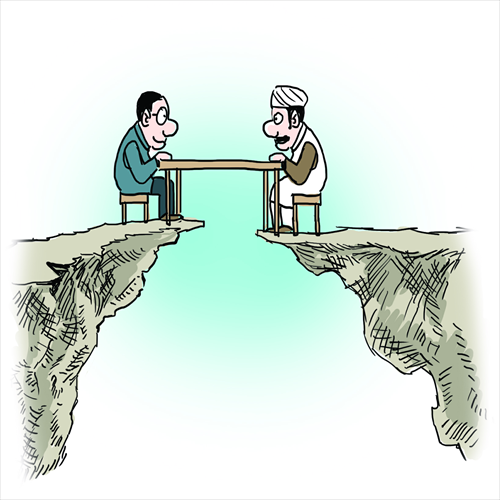Language builds bridges for India and China

Illustration: Liu Rui/GT
"If you talk to a man in a language he understands, that goes to his head. If you talk to him in his own language, that goes to his heart."
Both India and China seem to be endorsing this quote by African leader Nelson Mandela as they embrace each other's primary languages, Hindi and Chinese.
The efforts are opening up exciting new opportunities for business, travel and cultural enrichment as the two Asian giants embark upon a common program to bolster bilateral ties.
Several factors are fueling the surge to learn Chinese across India. Leading Indian corporations are doing business with firms across the border. Indian parents, students and educators believe that fluency in the language of the world's most populous country can be a ticket to success.
Across Indian academic institutions, there is a new and ostensible thrust to help students master Putonghua, the most widely spoken language across China, and by an estimated 873 million people worldwide.
Last month, India's State-managed Central Board of Secondary Education (CBSE), the premier national body governing schools, introduced Chinese in 22 schools across the country in synergy with Hanban, China's national office for teaching Chinese. Hanban has deputed native Chinese teachers to help students learn the language as well as familiarize them with Chinese art, culture and tradition.
Chinese, currently being taught on a pilot basis in India and offered as an elective option from class six to all CBSE-affiliated schools, will now be introduced as a full-fledged foreign language from April.
Indian universities too are reporting an upward spiral in youth enrolling for Chinese classes. A recent industry survey found that over 500 schools are keen on offering classes on the subject.
A memorandum of understanding signed between Beijing and New Delhi in 2012 envisages a robust exchange of academic staff, teachers, trainees, experts and students for learning Chinese across India and Hindi in China.
The initiative dovetails with Beijing and New Delhi's attempts to build a strategic and cooperative partnership while expanding trade and economic cooperation. China has emerged as India's biggest trading partner with trade figures ratcheting up from $7 billion in 2004 to $65 billion in 2013.
Private institutions offering crash courses in Chinese are also mushrooming across Indian cities. Propelling the demand further are the lucrative job opportunities that proficiency in Chinese opens up.
An interpreter, for instance, can take home as much as 3,500 rupee to 4,000 rupee daily ($57 to $65), while an undergraduate student of Chinese can pocket $800 per month as a tourist guide, two or three times what their contemporaries are making.
Acknowledging the enhanced employment opportunities the language proffers, the Department of East Asian Studies at Delhi University is offering post-graduate intensive diploma and intensive advance diploma courses in Chinese. The graduates of these courses find ready acceptance within major think tanks and multinational corporations as well as interpreters.
India will require at least 5,000 Chinese language experts, interpreters and translators every year for the next 10 years. However, the main challenge here is the shortfall in the number of teachers. This paucity bottlenecks the scaling up of the number of Indian schools keen to incorporate Chinese into their curriculum.
Hindi too, is finding a resonance with the Chinese. To tap the large Indian market, Chinese students from Yunnan University of Nationalities make frequent forays to the western state of Gujarat to learn Business Hindi.
Efforts at the institutional level have helped promote Hindi across swathes of China. In Kunming, the Yunnan University of Nationalities offers six foreign languages, one of which is Hindi.
Both China and India can build on complementarities and convergences by promoting each other's language to enrich people-to-people contacts.
Apart from understanding and appreciating each other's culture, such endeavors will truly shape the thinking of future generations and bring down the great wall of misunderstanding.
The author is a journalist based in New Delhi. neetalal@hotmail.com